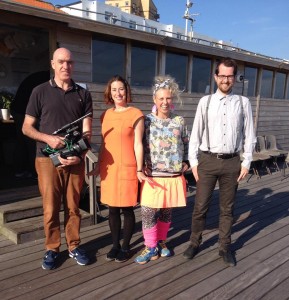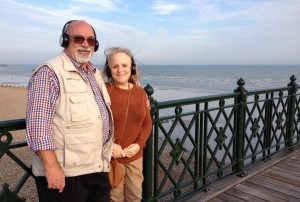by Olu Jenzen and Beatrice Rapley
The silent disco on the Hastings Pier was an event that aimed to test the potentials and limitations of telling the popular culture history of the pier through music. It was organised in September of 2015 as part of the Heritage Open Days.
As Matt Brennan notes
‘music has always been one of the most vital forms of seaside entertainment – whether we are talking about big bands and ballroom dancing in the 1930s and 1940s, juke boxes and rock ‘n’ roll in the 1950s, R&B and beat groups in the 1960s, or the visual spectacle of glam rock and punk shows in the 1970s.’
The event was a collaboration between The People’s Pier research project and the Hastings Pier Charity.
Olu and Archie produced a podcast that showcased the musical heritage of the pier from the 1960s to the 2000s, based on research into the pier as a music venue and space for the enjoyment of a wide range of popular culture by the research team in collaboration with the pier archive team volunteers. It featured music, oral history and various seaside sound effects.
The 1960s was a time when coastal resorts like Hastings were buzzing with vibrant youth culture although at the time they were mainly seen as troublesome by the press. It was not just that the mods and rockers clashed on the seafront, but the ballroom on the pier was a very popular live music venue throughout this beat group era – the Rolling Stones played Hastings Pier three times in 1964, but also groups such as The Kinks, The Who, The Zombies and artists such as Jimi Hendrix and Cilla Black sustained youth culture on the south coast as well as attracted young people down from London.
Hastings Pier has such a fantastically rich musical heritage – and is quite unique in how it became the host for waves of new types of music such as progressive and glam rock (Pink Floyd, The Nice, Genesis, Hawkwind, Sparks, T-Rex) and onward into the punk period (Sex Pistols, The Damned, The Clash, The Jam) and in the 1990s, as youth musical culture became more dance orientated again – like in the 1950s – Hastings Pier morphed into a rave party venue featuring acts such as the Prodigy.
Our challenge was to bring together factual information about the pier’s popular culture heritage – the sort of thing you expect from an audio guide – with a more immersive experience of history.  The approach we took was to record the podcast told mainly in present tense, as if the audience was there at a Rolling Stones concert in 1964 or found themselves emerging out onto the deck as the sun was rising, after a night at a rave in the 1990s.
The approach we took was to record the podcast told mainly in present tense, as if the audience was there at a Rolling Stones concert in 1964 or found themselves emerging out onto the deck as the sun was rising, after a night at a rave in the 1990s.
More importantly we really wanted to give the music a lot of room and this is something that the audience seemed to like a lot.
We used the silent disco technology, often used at big music festivals, to be able to broadcast the same content to a group of people at the same time, enabling them to enjoy the podcast side by side on the pier or to interact as an audience. The participants were kitted out with earphones and then the open air deck of the pier was theirs to enjoy for half an hour of amazing music. There was even some spontaneous dancing.  Going forward the podcast format can be developed into an app for smartphones or personal mp3 players for visitors to the pier to enjoy whenever they want.
Going forward the podcast format can be developed into an app for smartphones or personal mp3 players for visitors to the pier to enjoy whenever they want.
We ran one event for young people (16-24) and one for the older audience and it was interesting to note similarities and differences between the two groups. Those who had grown up with the pier as part of their youth in Hastings were really excited to be back on the pier and the podcast triggered a lot of memories for them. The younger audience were curious about the experience and really enjoyed learning about the musical lives and youth culture of older generations, although they did not themselves have the same attachment to the space in and of itself.

We gained a lot of very useful feedback on this pilot. The audience liked the journey through time and found it interesting to learn about the different types of music and pop cultures of the different decades, they added that it would be even better if you could select a decade at the time to explore, which we found was a brilliant idea and something to take forward for future design of interpretation material. Vignettes from Archie Lauchlan’s interviews with a range of people who have been involved in Hastings music scene or the pier over the years provided a rich texture to the podcast as well, like life narratives do and like any story told well they brought smiles to the faces of the participants.
There is plenty more to explore about the popular culture heritage of seaside piers and Hasting Pier has a long musical history that stretches back in time to the Victorian era which means plenty of more of its archives can be drawn on to take audiences on a time travel experience through music.
Check out the silent disco on the pier playlist on spotify:
This post is an edited version of our article published on the BBC website.
